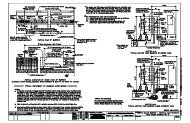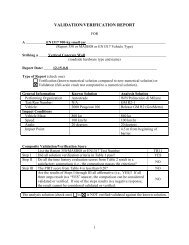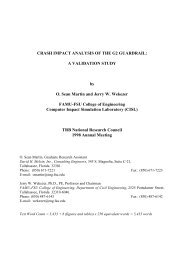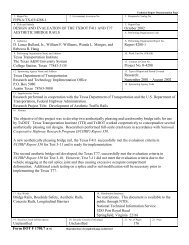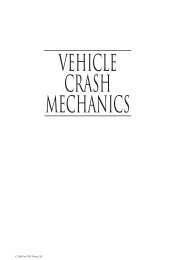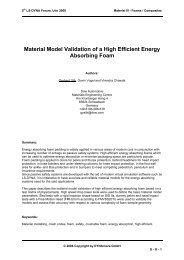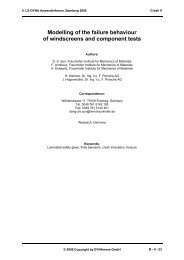Vehicle Crashworthiness and Occupant Protection - Chapter 3
Vehicle Crashworthiness and Occupant Protection - Chapter 3
Vehicle Crashworthiness and Occupant Protection - Chapter 3
Create successful ePaper yourself
Turn your PDF publications into a flip-book with our unique Google optimized e-Paper software.
Finite Element Analytical Techniques<br />
<strong>and</strong> Applications to Structural Design<br />
3.6.3.2 Contact Definitions<br />
A rigid wall was defined in front of the vehicle with stick condition. Automatic<br />
contact surfaces were defined in six zones as follows:<br />
• Front-left corner (up to front body hinge pillar)<br />
• Front-right corner (up to front body hinge pillar)<br />
• Front-center (include up to the middle of the engine)<br />
• Rear-center (from middle of the engine to the fire wall)<br />
• Driver side center-pillar to door<br />
• Passenger side center-pillar to door<br />
3.6.3.3 Initial Condition<br />
An initial velocity of 13.4 m/s was defined for the entire vehicle structure which<br />
impacted a rigid wall.<br />
3.6.3.4 Results<br />
The model response was calculated on a CRAY Y-MP8E system. The time step<br />
was approximately 0.7 ¼s. A 100 ms simulation was completed in about 45 hours<br />
on one processor. In this run, it was necessary to refine the radiator model since<br />
severe hourglassing was observed. The initial (at time 0) <strong>and</strong> final (at 100 ms)<br />
vehicle deformed shapes are shown in Figure 3.6.3.4.1. Intermediate vehicle<br />
configurations (not shown here) exhibited realistic sequential deformations as<br />
seen in high-speed film analysis of barrier crashes. The time histories of the<br />
global energy balance, velocity at the front rocker, <strong>and</strong> barrier force provided<br />
very reasonable results, comparable to test data [51].<br />
In addition to frontal crash models, other models have been developed to simulate<br />
side impact with a deformable barrier [52], rear impact, <strong>and</strong> roof crush models,<br />
respectively [53]. Also, car-to-car crash models have been simulated [54].<br />
3.6.4 Integrated <strong>Vehicle</strong>-<strong>Occupant</strong>-Restraints Model<br />
Traditionally, frontal crashworthiness analysis has focused on sequential<br />
simulations of vehicle structures <strong>and</strong> occupants, with the occupant simulation<br />
being driven by the vehicle (calculated or measured) deceleration pulse.<br />
Consequently, analysis techniques <strong>and</strong> associated tools have been developed to<br />
meet the needs of the two communities. This process has many shortcomings,<br />
including real-time interactions between the occupant <strong>and</strong> vehicle structure during<br />
the crash event are not simulated, the analyst must learn <strong>and</strong> use two analysis<br />
Page 143



